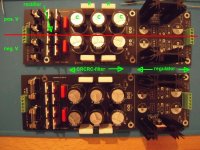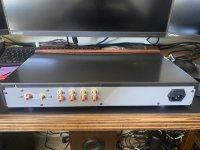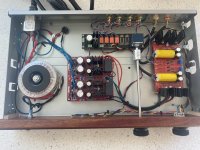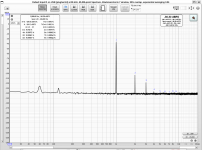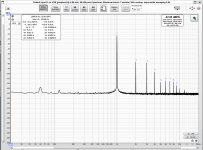I have used transformers with 24 V AC secondaries (30W or 50W). After the CRC-filter I've got around
32 - 34.5 V DC.
If you add a regulator, then it should have something to regulate - down (to work properly). So I ended
at around 31-32 V DC max. (with the regulators). But I always use adjustable regulators (LM317/LM337
or LinearTechnology LT1085/LT1033. So I can adjust the voltage over the trimpots (see datasheets).
All the suggestions for PSUs above are good.
Cheers
Dirk
32 - 34.5 V DC.
If you add a regulator, then it should have something to regulate - down (to work properly). So I ended
at around 31-32 V DC max. (with the regulators). But I always use adjustable regulators (LM317/LM337
or LinearTechnology LT1085/LT1033. So I can adjust the voltage over the trimpots (see datasheets).
All the suggestions for PSUs above are good.
Cheers
Dirk
I’ve used the same power supply with an Antek 50va 22v. Works perfect! Good luck with your buildI am ordering parts for a BA-3. I wanted to see if this would be a good power supply to use:
https://glass-ware.stores.yahoo.net/dulv.html
For 24V DC output, would an antec AS-0520 - 50va 20v be good or should I go higher?
I am looking for a simple solution for the power supply. I have Gaz's helios bipolar supply board but It seems to only be good for around 18v. I want to go a little higher than that.
Thanks!
25v. Here are a few pics of my buildNice, what voltage did you see with the linestage installed and running?
Attachments
Last edited:
Hello, may I ask what is the horizontal board in the upper side of the case where the volume pot is attached to?25v. Here are a few pics of my build
This is Salas‘ i-select, great jig!
https://www.diyaudio.com/community/...nd-volume-control.291429/page-14#post-6730937
https://www.diyaudio.com/community/...nd-volume-control.291429/page-14#post-6730937
That is correct! I’ve used it in multiple preamp builds and love itThis is Salas‘ i-select, great jig!
https://www.diyaudio.com/community/...nd-volume-control.291429/page-14#post-6730937
Hi All,
I've been fiddling with the BA-3 preamp I posted about in #2324 above, and measuring some stuff with REW. I've added more capacitance to the power supply, specifically 6800uF followed by 27R on each rail before the CLCLC. I suspect the nice-looking inductors are too low value to be doing much, and maybe the whole CRCLCLC chain is really more like CRC, but nonetheless the preamp sounds good, and the REW plots seem to show reasonable performance, so that's good. I might replace with some sort of regulated supply at some point, but it's not a priority.
I'm posting three RTA plots from REW. All for the left channel (R looks similar) Using a Focusrite Solo, with a 1kHz test signal at 0.947V, and measured at three output levels; 0.936V (unity gain), 1.951V (more or less 2x gain), and 9.44V (full volume). I'd be interested in any comments on these, in particular the third, at 9V. I'm not at all concerned about the little peaks at 60Hz and 120Hz; I'm sure a better PSU could help, and in any event they're small, and (as far as I can tell) inaudible. Also the general noise levels are good, I think. I've been comparing with a diy Iron Pre that I've posted about elsewhere, which measures a little better when used for gain similar to the first two, but I have no other preamp with similar gain to compare the third plot with, and until I build the power amps this thing was built to be used with (MoFo and similar) I have no way to see how good it sounds at these levels. (Volume is similar to the first plot when using it with my diy FirstWatt amps, and it sounds great there.)
So I have a couple of question:
1. How do these plots compare with what you guys are getting with BA-3 preamp builds? The first two look good to me, the third I'm not so sure about. How does 0.26%THD compare with what you're seeing at full gain? I've not tried to tweak P3 too much, so I could presumably reduce this a little, although probably not still keeping H2 above H3. (If that matters...)
2. My best guess is that my Rube Goldberg PSU may well be contributing to noise (and 60Hz/120Hz peaks) but the H2 and H3 peaks are caused by the preamp board, right?
Thanks for any input.
Nigel
I've been fiddling with the BA-3 preamp I posted about in #2324 above, and measuring some stuff with REW. I've added more capacitance to the power supply, specifically 6800uF followed by 27R on each rail before the CLCLC. I suspect the nice-looking inductors are too low value to be doing much, and maybe the whole CRCLCLC chain is really more like CRC, but nonetheless the preamp sounds good, and the REW plots seem to show reasonable performance, so that's good. I might replace with some sort of regulated supply at some point, but it's not a priority.
I'm posting three RTA plots from REW. All for the left channel (R looks similar) Using a Focusrite Solo, with a 1kHz test signal at 0.947V, and measured at three output levels; 0.936V (unity gain), 1.951V (more or less 2x gain), and 9.44V (full volume). I'd be interested in any comments on these, in particular the third, at 9V. I'm not at all concerned about the little peaks at 60Hz and 120Hz; I'm sure a better PSU could help, and in any event they're small, and (as far as I can tell) inaudible. Also the general noise levels are good, I think. I've been comparing with a diy Iron Pre that I've posted about elsewhere, which measures a little better when used for gain similar to the first two, but I have no other preamp with similar gain to compare the third plot with, and until I build the power amps this thing was built to be used with (MoFo and similar) I have no way to see how good it sounds at these levels. (Volume is similar to the first plot when using it with my diy FirstWatt amps, and it sounds great there.)
So I have a couple of question:
1. How do these plots compare with what you guys are getting with BA-3 preamp builds? The first two look good to me, the third I'm not so sure about. How does 0.26%THD compare with what you're seeing at full gain? I've not tried to tweak P3 too much, so I could presumably reduce this a little, although probably not still keeping H2 above H3. (If that matters...)
2. My best guess is that my Rube Goldberg PSU may well be contributing to noise (and 60Hz/120Hz peaks) but the H2 and H3 peaks are caused by the preamp board, right?
Thanks for any input.
Nigel
Attachments
Hello njepitt,
pot3 on the BA-3-board is there to adjust the balance of 2nd- and 3rd- harmonic. If you adjust P3 you always have to do your bias-up-procedure again.
50/60Hz and 100/120Hz is typical noise from the AC-mains (for me).
And you are at -135dB with your noisefloor. What should be much better?
I would say, you should listen to it.
Have fun!
Cheers
Dirk 🙂
pot3 on the BA-3-board is there to adjust the balance of 2nd- and 3rd- harmonic. If you adjust P3 you always have to do your bias-up-procedure again.
50/60Hz and 100/120Hz is typical noise from the AC-mains (for me).
And you are at -135dB with your noisefloor. What should be much better?
I would say, you should listen to it.
Have fun!
Cheers
Dirk 🙂
Hi Dirk,
Thanks for the reply. I have fiddled a little with P3, although not too much yet, but it's not so much the balance I'm asking about, but how good other people's THD (and scans) are at full volume. Have you measured yours?
Like I said above, I'm not at all concerned with the noise, which (as you say) is pretty good. I'm still surprised such a crude PSU seems to do as well as it does.
Best
Nigel
Thanks for the reply. I have fiddled a little with P3, although not too much yet, but it's not so much the balance I'm asking about, but how good other people's THD (and scans) are at full volume. Have you measured yours?
Like I said above, I'm not at all concerned with the noise, which (as you say) is pretty good. I'm still surprised such a crude PSU seems to do as well as it does.
Best
Nigel
I have not measured mine.
I am just listening and enjoying it.
I did adjust P3 "by ear" a couple of turns one way sounded colder, perhaps clearer?
A couple of turns the other way sounded richer and warmer, that's where I left it. After re-biasing and zeroing offset.
I am just listening and enjoying it.
I did adjust P3 "by ear" a couple of turns one way sounded colder, perhaps clearer?
A couple of turns the other way sounded richer and warmer, that's where I left it. After re-biasing and zeroing offset.
I did the same thing with P3 when I first built it, and had the same experience. And it sounds good. But I'd like to understand things a little better if I can.I have not measured mine.
I am just listening and enjoying it.
I did adjust P3 "by ear" a couple of turns one way sounded colder, perhaps clearer?
A couple of turns the other way sounded richer and warmer, that's where I left it. After re-biasing and zeroing offset.
Nigel
Hello njepitt,
for a better understanding, you could read this articles from Nelson Pass:
https://www.firstwatt.com/pdf/art_dist_fdbk.pdf
https://www.firstwatt.com/pdf/art_ba_3.pdf
The BA-3 (frontend) is a non-feedback design. You could get lower distortion numbers by adding feedback.
But the designer was searching for something else...
Cheers
Dirk
for a better understanding, you could read this articles from Nelson Pass:
https://www.firstwatt.com/pdf/art_dist_fdbk.pdf
https://www.firstwatt.com/pdf/art_ba_3.pdf
The BA-3 (frontend) is a non-feedback design. You could get lower distortion numbers by adding feedback.
But the designer was searching for something else...
Cheers
Dirk
For a BA-3+F4 combination, would a single 24V power supply suffice?
Something like the SLB for example: https://www.diyaudio.com/community/...ct-crc-cap-mx-class-a-power-supply-gb.336479/
Something like the SLB for example: https://www.diyaudio.com/community/...ct-crc-cap-mx-class-a-power-supply-gb.336479/
Hello Nikodemuzz,
a BA-3 frontend combined with a F4 is very similar to a BA-3-poweramp (BA-3 - frontend + complementary
bias and outputset.
The frontend 'sucks' approximately 100mA (for both channels) and the outputstage of an F4 much more.
Depends on how high you want to bias the outputstage.
In the 'smooth like butter'-thread of XRKaudio is mentioned, that it can deliver up to 5 A. I don't see any
argument against your plan. But I haven't built this combination!
Perhaps others can chime in.
Cheers
Dirk
a BA-3 frontend combined with a F4 is very similar to a BA-3-poweramp (BA-3 - frontend + complementary
bias and outputset.
The frontend 'sucks' approximately 100mA (for both channels) and the outputstage of an F4 much more.
Depends on how high you want to bias the outputstage.
In the 'smooth like butter'-thread of XRKaudio is mentioned, that it can deliver up to 5 A. I don't see any
argument against your plan. But I haven't built this combination!
Perhaps others can chime in.
Cheers
Dirk
I agree with Dirk. If your plan is to build the BA3 front end with the F4 in a single unit and without additional
I/O connections between these two components then I would suggest just building the BA3 FE + BA2 complementary output stage and save a set of jfets.
I/O connections between these two components then I would suggest just building the BA3 FE + BA2 complementary output stage and save a set of jfets.
Thank you @Dennis Hui and @cubicincher! I've read mentions about the similarity of the Burning Amp output stage and the F4, but haven't exactly realized what the possible differences are. I'll have to properly read the article about the BA-2 as well. Anyhow, building the amp as an entire Burning Amp unit seems like a solid option if it accomplishes essentially the same thing as the F4.I agree with Dirk. If your plan is to build the BA3 front end with the F4 in a single unit and without additional
I/O connections between these two components then I would suggest just building the BA3 FE + BA2 complementary output stage and save a set of jfets.
- Home
- Amplifiers
- Pass Labs
- The BA-3 as preamp build guide
